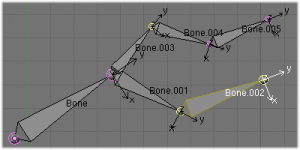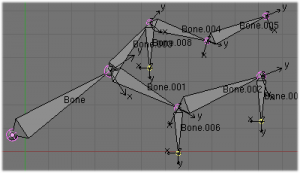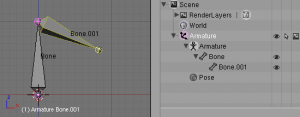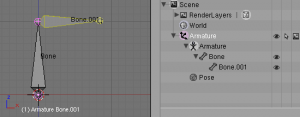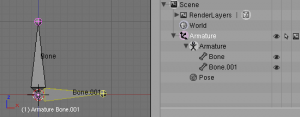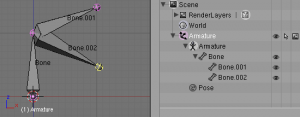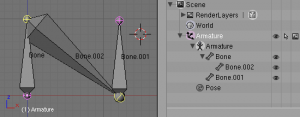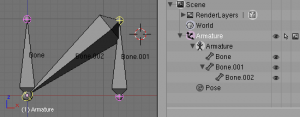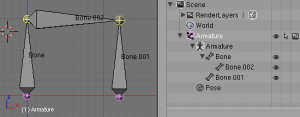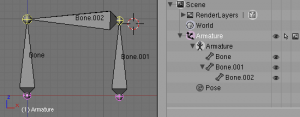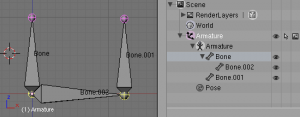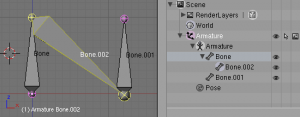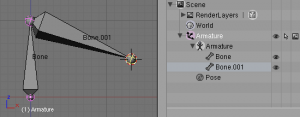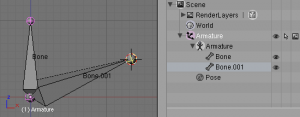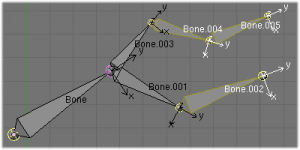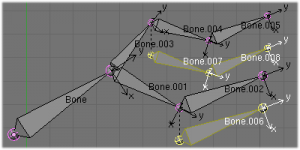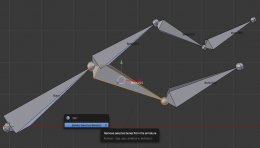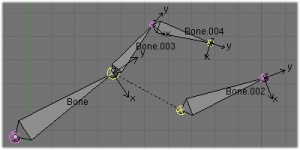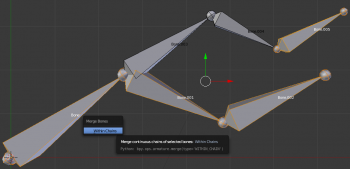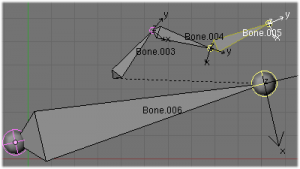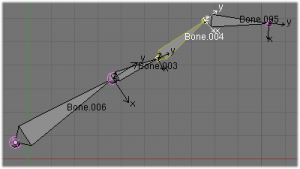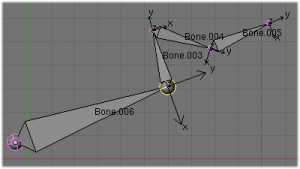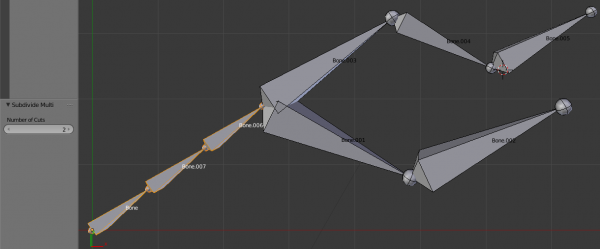Doc:2.6/Manual/Rigging/Armatures/Editing/Bones
Editing Bones
Mode: Edit mode
Hotkey: ⇆ Tab
You’ll learn here how to add, delete or subdivide bones. We will also see how to prevent any bone transformation in Edit mode, and the option that features an automatic mirroring of editing actions along the X axis.
Adding Bones
To add bones to your armature, you have more or less the same options as when editing meshes:
Add Menu
Mode: Edit mode
Hotkey: ⇧ ShiftA
In the 3D view, ⇧ ShiftA » Bone to add a new bone to your armature.
This bone will be:
- of one Blender Unit of length,
- oriented towards the positive Y axis of the view,
- with its root placed at the 3D cursor position,
- with no relationship with any other bone of the armature.
Extrusion
Mode: Edit mode
Hotkey: E, ⇧ ShiftE
Menu: Armature » Extrude
When you press the E key, for each selected tip (either explicitly or implicitly), a new bone is created. This bone will be the child of “its” tip owner, and connected to it. As usual, once extrusion is done, only the new bones’ tips are selected, and in grab mode, so you can place them to your liking. See (Extrusion example).
You also can use the rotating/scaling extrusions, as explained for meshes here, by hitting respectively ER and ES – as well as “locked” extrusion along a global or local axis.
Bones have an extra “mirror extruding” tool, called by hitting ⇧ ShiftE. By default, it behaves exactly like the standard extrusion. But once you have enabled the X-Axis mirror editing option (see below), each extruded tip will produce two new bones, having the same name except for a leading “_L/_R” code (for left/right, see the next page). The “_L” bone behaves like the single one produced by the default extrusion – you can grab/rotate/scale it exactly the same way. The “_R” bone is its mirror counterpart (along the armature’s local X axis), see (Mirror extrusion example).
Note that exactly as in mesh editing, if you press Esc right after you have pressed E, the extruded bones will be there but their length will be zero, so very likely this will give you some headaches. If you realize the problem immediately, you can undo by pressing CtrlZ.
In case you're wondering, you cannot just press X to solve this as you would in mesh editing, because extrusion selects the newly created tips, and as explained below the delete command ignores bones' ends. To get rid of these extruded bones without undoing, you would have to move the tips, then select the bones and delete them.
Mouse Clicks
If at least one bone is selected, CtrlLMB ![]() -clicking adds a new bone.
-clicking adds a new bone.
About the new bone's tip:
- after you CtrlLMB
 -clicked it becomes the active element in the armature,
-clicked it becomes the active element in the armature, - it appears to be right where you clicked, but…
- …(as in mesh editing) it will be on the plane parallel to the view and passing through the 3D cursor.
The position of the root and the parenting of the new bone depends on the active element:
If the active element is a bone
- the new bone's root is placed on the active bone's tip
- the new bone is parented and connected to the active bone (check the outliner in Ctrl-clicking when the active element is a bone).
If the active element is a tip:
- the new bone's root is placed on the active tip
- the new bone is parented and connected to the bone owning the active tip (check the outliner in Ctrl-clicking when the active element is a tip).
If the active element is a disconnected root:
- the new bone's root is placed on the active root
- the new bone is NOT parented to the bone owning the active root (check the outliner in Ctrl-clicking when the active element is a disconnected root).
And hence the new bone will not be connected to any bone.
If the active element is a connected root:
- the new bone's root is placed on the active root
- the new bone IS parented and connected to the parent of the bone owning the active root (check the outliner in Ctrl-clicking when the active element is a connected root).
This should be obvious because if the active element is a connected root then the active element is also the tip of the parent bone, so it is the same as the second case.
As the tip of the new bone becomes the active element, you can repeat these ctrl-clicks several times, to consecutively add several bones to the end of the same chain.
Fill between joints
Mode: Edit mode
Hotkey: F
Menu: Armature » Fill Between Joints
The main use of this tool is to create one bone between two selected ends by pressing F, similar to how in mesh editing you can “create edges/faces”.
If you have one root and one tip selected, the new bone:
- will have the root placed on the selected tip
- will have the tip placed on the selected root
- will be parented and connected to the bone owning the selected tip
If you have two tips selected, the new bone:
- will have the root placed on the selected tip closest to the 3D cursor
- will have the tip placed on the other selected tip
- will be parented and connected to the bone owning the tip used as the new bone's root
If you have two roots selected, you will face a small problem due to the event system in Blender not updating the interface in real time.
When clicking F, similar to the previous case, you will see a new bone:
- with the root placed on the selected root closest to the 3D cursor
- with the tip placed on the other selected root
- parented and connected to the bone owning the root used as the new bone's root
If you try to move the new bone, Blender will update the interface and you will see that the new bone's root moves to the tip of the parent bone.
Clicking F with only one bone end selected will create a bone from the selected end to the 3D cursor position, and it won't parent it to any bone in the armature.
You will get an error when:
- trying to fill two ends of the same bone, or
- trying to fill more than two bone ends.
Duplication
Mode: Edit mode
Hotkey: ⇧ ShiftD
Menu: Armature » Duplicate
This tool works on selected bones; selected ends are ignored.
As in mesh editing, by pressing ⇧ ShiftD:
- the selected bones will be duplicated,
- the duplicates become the selected elements and they are placed in grab mode, so you can move them wherever you like.
If you select part of a chain, by duplicating it you’ll get a copy of the selected chain, so the copied bones are interconnected exactly like the original ones.
The duplicate of a bone which is parented to another bone will also be parented to the same bone, even if the root bone is not selected for the duplication. Be aware, though, that if a bone is parented and connected to an unselected bone, its copy will be parented but not connected to the unselected bone (see Duplication example).
Deleting Bones
You have two ways to remove bones from an armature: the standard deletion, and merging several bones in one.
Standard deletion
Mode: Edit mode
Hotkey: X
Menu: Armature » Delete
This tool works on selected bones: selected ends are ignored.
To delete a bone, you can:
- press the standard X key and confirm, or
- use the menu Armature » Delete and confirm.
If you delete a bone in a chain, its child(ren) will be automatically re-parented to its own parent, but not connected, to avoid deforming the whole armature.
Merge
Mode: Edit mode
Hotkey: AltM
Menu: Armature » Merge
You can merge together several selected bones, as long as they form a chain. Each sub-chain formed by the selected bones will give one bone, whose root will be the root of the root bone, and whose tip will be the tip of the tip bone.
Confirm by clicking on Within Chains in the Merge Selected Bones pop-up.
If another (non-selected) chain origins from inside of the merged chain of bones, it will be parented to the resultant merged bone. If they were connected, it will be connected to the new bone.
Here's a strange subtlety (see Merge example): even though connected (the root bone of the unmerged chain has no root sphere), the bones are not visually connected – this will be done as soon as you edit one bone, differently depending in which chain is the edited bone (compare the bottom two images of the example to understand this better).
Subdividing Bones
Mode: Edit mode
Hotkey: W1, W2
Menu: Armature » Subdivide, Armature » Subdivide Multi
You can subdivide bones, to get two or more bones where there was just one bone. The tool will subdivide all selected bones, preserving the existing relationships: the bones created from a subdivision always form a connected chain of bones.
To create two bones out of each selected bone:
- press W » Subdivide, same as W1, or
- select Armature » Subdivide from the header menu
To create an arbitrary number of bones from each selected bone:
- in Subdivide options on the Toolshelf in Subdivide Multi section specify the number of cuts you want. As in mesh editing, if you set
ncuts, you’ll getn+1bones for each selected bone.
Locking Bones
You can prevent a bone from being transformed in Edit mode in several ways:
- The active bone can be locked clicking on the Lock button in Transform panel of the Bone context;
- All selected bones can be locked pressing ⇧ ShiftW » Toggle Bone Options » Lock or
- select Armature » Bone Settings » Lock) in 3D-header.
If the root of a locked bone is connected to the tip of an unlocked bone, it won’t be locked, i.e. you will be able to move it to your liking. This means that in a chain of connected bones, when you lock one bone, you only really lock its tip. With unconnected bones, the locking is effective on both ends of the bone.
X-Axis Mirror Editing
Another very useful tool is the X-Axis Mirror editing option (Tool panel > Armature Options, while Armature is selected in Edit Mode), working a bit like the same mesh editing tool. When you have pairs of bones of the same name with just a different “side suffix” (e.g. .R/.L, or _right/_left…), once this option is enabled, each time you transform (move/rotate/scale…) a bone, its “other side” counterpart will be transformed accordingly, through a symmetry along the armature local X axis. As most rigs have at least one axis of symmetry (animals, humans, …), it’s an easy way to spare you half of the editing work! See also next page for more on naming bones.
Separating Bones in a new Armature
You can, as with meshes, separate the selected bones in a new armature object (Armature » Separate, CtrlAltP) – and of course, in Object mode, you can join all selected armatures in one (Object » Join Objects, CtrlJ).
